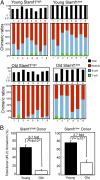Functionally distinct hematopoietic stem cells modulate hematopoietic lineage potential during aging by a mechanism of clonal expansion
- PMID: 20304793
- PMCID: PMC2851806
- DOI: 10.1073/pnas.1000834107
Functionally distinct hematopoietic stem cells modulate hematopoietic lineage potential during aging by a mechanism of clonal expansion
Abstract
Aging of the hematopoietic stem cell compartment is believed to contribute to the onset of a variety of age-dependent blood cell pathophysiologies. Mechanistic drivers of hematopoietic stem cell (HSC) aging include DNA damage accumulation and induction of tumor suppressor pathways that combine to reduce the regenerative capacity of aged HSCs. Such mechanisms do not however account for the change in lymphoid and myeloid lineage potential characteristic of HSC aging, which is believed to be central to the decline of immune competence and predisposition to myelogenous diseases in the elderly. Here we have prospectively isolated functionally distinct HSC clonal subtypes, based on cell surface phenotype, bearing intrinsically different capacities to differentiate toward lymphoid and myeloid effector cells mediated by quantitative differences in lineage priming. Finally, we present data supporting a model in which clonal expansion of a class of intrinsically myeloid-biased HSCs with robust self-renewal potential is a central component of hematopoietic aging.
Conflict of interest statement
The authors declare no conflict of interest.
Figures




Similar articles
-
Microbiota Signals Suppress B Lymphopoiesis With Aging in Mice.Front Immunol. 2021 Oct 19;12:767267. doi: 10.3389/fimmu.2021.767267. eCollection 2021. Front Immunol. 2021. PMID: 34737755 Free PMC article.
-
SLAM family markers resolve functionally distinct subpopulations of hematopoietic stem cells and multipotent progenitors.Cell Stem Cell. 2013 Jul 3;13(1):102-16. doi: 10.1016/j.stem.2013.05.014. Cell Stem Cell. 2013. PMID: 23827712 Free PMC article.
-
CD41 expression marks myeloid-biased adult hematopoietic stem cells and increases with age.Blood. 2013 May 30;121(22):4463-72. doi: 10.1182/blood-2012-09-457929. Epub 2013 Apr 5. Blood. 2013. PMID: 23564910
-
Immunoaging induced by hematopoietic stem cell aging.Curr Opin Immunol. 2011 Aug;23(4):532-6. doi: 10.1016/j.coi.2011.05.004. Curr Opin Immunol. 2011. PMID: 21872769 Review.
-
Aging in the lympho-hematopoietic stem cell compartment.Trends Immunol. 2009 Jul;30(7):360-5. doi: 10.1016/j.it.2009.03.010. Epub 2009 Jun 18. Trends Immunol. 2009. PMID: 19540806 Review.
Cited by
-
Sex-dependent differences in hematopoietic stem cell aging and leukemogenic potential.Oncogene. 2025 Jan;44(2):64-78. doi: 10.1038/s41388-024-03197-9. Epub 2024 Nov 1. Oncogene. 2025. PMID: 39487323 Free PMC article.
-
Concise review: hematopoietic stem cell aging, life span, and transplantation.Stem Cells Transl Med. 2012 Sep;1(9):651-7. doi: 10.5966/sctm.2012-0033. Epub 2012 Sep 5. Stem Cells Transl Med. 2012. PMID: 23197871 Free PMC article. Review.
-
Ageing-Associated Oxidative Stress and Inflammation Are Alleviated by Products from Grapes.Oxid Med Cell Longev. 2016;2016:6236309. doi: 10.1155/2016/6236309. Epub 2016 Feb 29. Oxid Med Cell Longev. 2016. PMID: 27034739 Free PMC article. Review.
-
Hand in hand: intrinsic and extrinsic drivers of aging and clonal hematopoiesis.Exp Hematol. 2020 Nov;91:1-9. doi: 10.1016/j.exphem.2020.09.197. Epub 2020 Sep 28. Exp Hematol. 2020. PMID: 32991978 Free PMC article. Review.
-
Transplantation Dose Alters the Differentiation Program of Hematopoietic Stem Cells.Cell Rep. 2016 May 24;15(8):1848-57. doi: 10.1016/j.celrep.2016.04.061. Epub 2016 May 12. Cell Rep. 2016. PMID: 27184851 Free PMC article.
References
-
- Miyamoto T, Akashi K. Lineage promiscuous expression of transcription factors in normal hematopoiesis. Int J Hematol. 2005;81:361–367. - PubMed
-
- Muller-Sieburg CE, Cho RH, Karlsson L, Huang JF, Sieburg HB. Myeloid-biased hematopoietic stem cells have extensive self-renewal capacity but generate diminished lymphoid progeny with impaired IL-7 responsiveness. Blood. 2004;103:4111–4118. - PubMed
-
- Dykstra B, et al. Long-term propagation of distinct hematopoietic differentiation programs in vivo. Cell Stem Cell. 2007;1:218–229. - PubMed
-
- Kent DG, et al. Prospective isolation and molecular characterization of hema-topoietic stem cells with durable self-renewal potential. Blood. 2009;113:6342–6350. - PubMed
Publication types
MeSH terms
Substances
Grants and funding
LinkOut - more resources
Full Text Sources
Other Literature Sources
Medical

